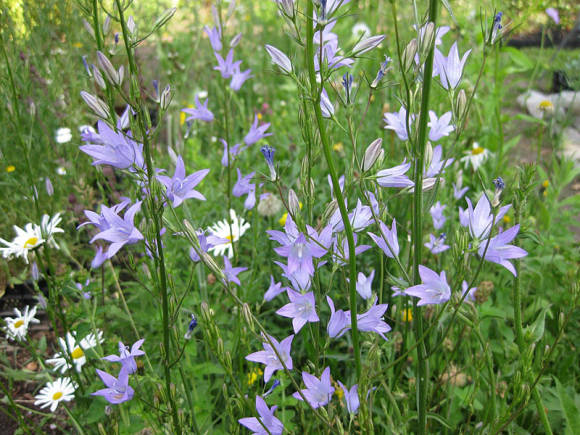In general, there are more than 400 species of bluebells, but unlike many other genera, they are somehow rarely mentioned as both medicinal and edible plants.
 |
Once upon a time, in childhood, many of us read the fairy tale of the Brothers Grimm about the girl Rapunzel with very long and beautiful hair. But few people thought that this is the name of one of the types of bells. Its botanical name is rapunzel bell, or bell onion (Campanula rapunculus L.). According to the latest botanical classifications, it has a number of synonyms (The Plant List for 2010): Campanula esculenta SALISB., Campanula patula var. rapunculus (L.) KUNTZE and Neocodon rapunculus (L.) KOLAK. & SERDYUK.
This is a biennial plant that forms a rosette of leaves and a fleshy turnip root in the first year. In the wild, it is found almost throughout Europe, without rising to a height of more than 1000 m above sea level, in dry meadows, roadsides, forest edges, and even as an ornamental plant in gardens.
Rapunzel during the flowering period reaches a height of 40-70 cm, and in the first year of life it forms only a rosette, the height of which does not exceed 20 cm. The leaves of the rosette are elongated-rounded, but as they move up the peduncle they become lanceolate. The flowers are located on a branched peduncle. Outwardly, these are classic blue bells, rather typical for representatives of the genus, although sometimes forms with a white color are found in gardens. Blooms, depending on the place of growth, from June to August. The seeds are small, brown.
 |
Actually, and the Latin name rapunculus translated as turnip. Until the 17th century, rapunzel could be found in peasant gardens throughout Europe, and in Switzerland and Alsace it was cultivated until the beginning of the 20th century as a vegetable. Fleshy roots were dug up from autumn during winter until spring, because in Central and Western Europe the soil practically does not freeze. The larger roots were boiled like turnips as a side dish. They taste sweet and are considered by many to have a nutty flavor. A winter salad was prepared from the smaller roots, which was seasoned with vinegar, salt and pepper. Rosettes of leaves were prepared similarly to valerian, and young peduncles in spring were prepared similarly to asparagus. In addition, since the Middle Ages, Europeans associated this plant with the mysterious world of elves and gnomes.
Useful properties of rapunzel
In medical terms, information about its use is rather scarce, it is known only from old herbalists that the decoction of the roots was used for inflammatory diseases of the throat and oral cavity, and the tincture of the whole plant rejuvenates the skin of the face and gives a radiant appearance. The famous botanist Leonard Fuchs attributed rapunzel ... to turnips. He pointed out that the root, seasoned with wine vinegar and salt, stimulates appetite and acts as a diuretic. In addition, he pointed out that outwardly, in a mixture with ground lupine seeds, wheat flour and ground cockle seeds (seed cockle is a harmful weed) cleanses the face and body. Most likely, this refers to the use of the plant for skin diseases. In addition, L. Fuchs recommended using the juice of the plant mixed with human milk for eye diseases. The English phytotherapist John Gerard recommended a decoction of the roots for gargling for diseases of the throat and tonsils (probably, it was about sore throat).
But in later sources, these memories are already, alas, absent. Now it is more likely to meet it as an ornamental plant, for example, there are varieties and hybrids of Heavenly Blue F1.
It is often confused with a similar look. Campanula rapunculoides - Rapunzel-shaped bell or onion-shaped bell, which is also referred to as food plants in some books.
Sowing and growing
 |
To begin with, it is better to choose a site that is well lit, with loose and fertile soil. When applying organic fertilizers, the compost should be taken very well rotted.Bellflower seeds are very small, and therefore, for sowing, it is better to mix them with an equal amount of sand in order to evenly distribute them in the rows, and the seedlings did not have to be thinned too much. In the garden, they are sown in early spring with a distance between rows of 20-25 cm. The seeds are slightly sprinkled with soil and watered. In order to avoid drying out of the soil surface, it is possible to cover them with agril, which should be removed as soon as shoots appear. Given the "smallness" of seedlings, you can use radish as a lighthouse culture. At the first stage, rapidly emerging radish plants will mark the rows, which will facilitate weeding, but after a month and a half, the radish will be eaten and make room for the development of rapunzel. After almost 1.5-2 months, you can already collect the leaves for the salad.
To use the roots, you need to wait until autumn. The roots are best kept in the basement in the sand, as we store carrots. In areas where the soil almost does not freeze, they can be mulched with peat and dug out throughout the winter as needed. As far as plants are left to winter for seeds. But I want to warn you right away that this is possible in the southern and partly in the central black earth regions. We have a high probability of freezing in the Moscow region.
Boxes with seeds are collected as they ripen, dried, spread out on paper, cleaned from the remains of the box and stored in paper bags. Seeds remain viable for about five years.
Here are the recipes found in the French book Forgotten Vegetables by François Kuplana: Rapunzel in Polish, Rapunzel Salad.









